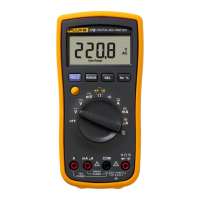Multimeters
Making Measurements
7
the effects of ac transients while making accurate dc
measurements.
1. Choose ac or dc by turning the rotary switch to , ,
or .
2. Connect the red test lead to the terminal and the
black test lead to the COM terminal.
3. Measure the voltage by touching the probes to the
desired test points of the circuit.
4. Read the measured voltage on the display.
Note
The only way to access the 400
range is by
manual ranging.
+
_ _
+
_
+
Volts AC Volts DC
Millivolts DC
V
V
mV
apg3f.eps
Figure 1. Measuring AC and DC Voltage
Measuring AC or DC Current
XW Warning
To prevent possible electrical shock, fire, or
personal injury, remove circuit power before
you connect the Product in the circuit when
you measure current. Connect the Product in
series with the circuit.
1. Turn the rotary switch to
, , or .
2. Toggle between ac or dc current measurement by
pressing the YELLOW button.
3. Connect the red test lead to either the A, or mA
terminal based on the current to be measured and
connect the black test lead to the COM terminal.
4. Break the circuit path to be measured. Then connect
the test leads across the break and apply power.
5. Read the measured current on the display.

